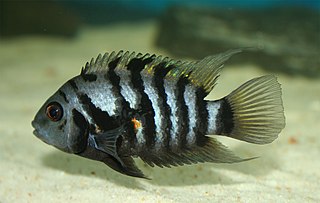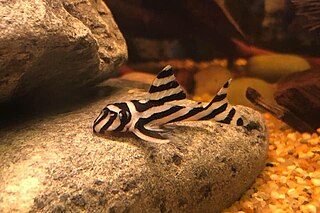
Cichlids are fish from the family Cichlidae in the order Cichliformes. Traditionally Cichlids were classed in a suborder, the Labroidei, along with the wrasses (Labridae), in the order Perciformes, but molecular studies have contradicted this grouping. On the basis of fossil evidence, it first appeared in Tanzania during the Eocene epoch, about 46–45 million years ago. The closest living relative of cichlids is probably the convict blenny, and both families are classified in the 5th edition of Fishes of the World as the two families in the Cichliformes, part of the subseries Ovalentaria. This family is large, diverse, and widely dispersed. At least 1,650 species have been scientifically described, making it one of the largest vertebrate families. New species are discovered annually, and many species remain undescribed. The actual number of species is therefore unknown, with estimates varying between 2,000 and 3,000.

The Jack Dempsey is a species of cichlid fish that is native to freshwater habitats from southern Mexico to Honduras, but also introduced elsewhere. Its common name refers to its aggressive nature and strong facial features, likened to that of the famous 1920s boxer Jack Dempsey.

Labidochromis caeruleus is a species of cichlid endemic to the central western coastal region of Lake Malawi in East Africa. It is also known as lemon yellow lab, the blue streak hap, the electric yellow or yellow prince, depending on the colour morph. A naturally occurring yellow-coloured variant from Lion's Cove is one of the most popular cichlids amongst aquarium hobbyists.

The firemouth cichlid is a species of cichlid fish native to Central America. They occur in rivers of the Yucatán Peninsula, Mexico, south through Belize and into northern Guatemala.

The convict cichlid is a fish species from the family Cichlidae, native to Central America, also known as the zebra cichlid. Convict cichlids are popular aquarium fish and have also been the subject of numerous studies on fish behaviour.

Julidochromis is a genus of cichlids in the subfamily Pseudocrenilabrinae. They are commonly called julies and are endemic to Lake Tanganyika in eastern Africa. This genus includes six formally described species, some with a number local variants of uncertain taxonomic status. Further taxonomic work is required to determine how many species exist; the closely related Chalinochromis with two more species is sometimes included here and this may be correct. Hybridization makes attempts to determine relationships with molecular phylogenetic methods difficult.

The zebra pleco is a species of catfish endemic to a small section of the Rio Xingu in Brazil. It occurs in the big bend area of the river, downstream from the town of Altamira, Para. It was first described in 1991. It gets its name from its black and white stripes, resembling the colouration of a zebra. This species grows to a length of 6.4 centimetres (2.5 in) SL. This species was exported from Brazil in 1987 for sale as aquarium fish. However, currently, the Brazilian government bans the export of certain fish species, including H. zebra.

The ram cichlid, Mikrogeophagus ramirezi, is a species of freshwater fish endemic to the Orinoco River basin, in the savannahs of Venezuela and Colombia in South America. The species has been examined in studies on fish behaviour and is a popular aquarium fish, traded under a variety of common names, including ram, blue ram, German blue ram, Asian ram, butterfly cichlid, Ramirez's dwarf cichlid, dwarf butterfly cichlid and Ramirezi. The species is a member of the family Cichlidae and subfamily Geophaginae.

Variabilichromis moorii has no common name and is a species of freshwater cichlid endemic to Lake Tanganyika in eastern Africa. It is a small ovate bodied fish named for an early collector of fish from the lake, John Edmund Sharrock Moore (1870-1947) who was a cytologist, zoologist and led an expedition to Lake Tanganyika and who discovered this species. Juveniles are usually yellow, and adults are dark brown to black in color. It reaches a total length (TL) of 10.3 centimetres (4.1 in). Currently it is the only member of its genus. V. moorii feeds on algae, zooplankton, and benthic invertebrates. It is also found in the aquarium trade.

Pelvicachromis pulcher is a freshwater fish of the cichlid family, endemic to Nigeria and Cameroon. It is popular amongst aquarium hobbyists, and is most commonly sold under the name kribensis, although it has other common names, including various derivatives and color morphs of the kribensis: krib, common krib, red krib, super-red krib and rainbow krib, along with rainbow cichlid and purple cichlid.

Archocentrus is a genus of cichlid fish from Central America. It currently contains a single species, the flier cichlid, which is found in stagnant and slow-moving freshwater habitats such as lakes, ponds, ditches, swamps and rivers in Honduras, Nicaragua and Costa Rica. It is up to 11 cm (4.3 in) long and feeds on invertebrates and detritus.

Melanochromis auratus, the auratus cichlid, is a freshwater fish of the cichlid family. It is also known as golden mbuna and Malawi golden cichlid. It is endemic to the southern region of Lake Malawi, particularly from Jalo Reef southward along the entire western coast down to Crocodile Rocks.

Pseudotropheus crabro, the Bumblebee Cichlid or Hornet Cichlid, is a species of cichlid endemic to Lake Malawi where it is found in different habitats but most frequently in large caves or in the vicinity of large boulders. This species can reach a length of 16 centimetres (6.3 in) SL.

Herotilapia multispinosa also known as the rainbow cichlid is a Central American freshwater fish of the cichlid family. It is found on the Atlantic slope of Honduras, Nicaragua, and Costa Rica from Patuca River (Honduras) south to Matina River, and on the Pacific slope of Nicaragua and Costa Rica from Guasaule River south to Tempisque River. Specimens are also reported from the Choluteca River on the Pacific side of Honduras. This species is found in lakes and swamps with muddy bottoms, where it uses its specialized teeth and only 3.5% jaw protrusion to feed mostly on algae. It is commercially important as an aquarium fish. The rainbow cichlid prefers a pH range of 7.0–8.0, water hardness of 9-20 dGH and a temperature range of 21–36 °C.
Parachromis motaguensis, the false yellowjacket cichlid, is a species of cichlid native to Central America, where it can be found in Guatemala, El Salvador, and Honduras. This species grows to a length of 30 centimetres (12 in) TL. This species is farmed.

The nkhomo-benga peacock, also known as the new yellow regal peacock, is a species of haplochromine cichlid which is endemic to Lake Malawi. This species is threatened by capture for the aquarium trade.

Amatitlania is a genus of cichlid fishes native to freshwater habitats in Central America from El Salvador and Guatemala to Panama. They are fairly small cichlids, typically reaching up to 6.4–10 cm (2.5–4 in) in standard length depending on exact species, although captives may grow larger.

Amatitlania septemfasciata is a fish species in the cichlid family. It is found on the Atlantic slope of Costa Rica, between the San Juan River drainage and the Banano River. Several currently recognized cichlid species within the genus Amatitlania were formerly considered varieties of Amatitlania septumfasciata, including Amatitlania myrnae, the Topaz Cichlid, and Amatitlania cutteri.

Hemichromis letourneuxi is a species of cichlid which is native to West Africa and is popular in the aquarium hobby and it has been introduced to the Caribbean and the south-east United States where it is invasive.

Andinoacara coeruleopunctatus, also known as chogorro and blue-point flag cichlid, is a species of fish in the family Cichlidae. It is found in Central America on both the Atlantic slope of Panama and the Pacific slope of Costa Rica in the Coto River.



















